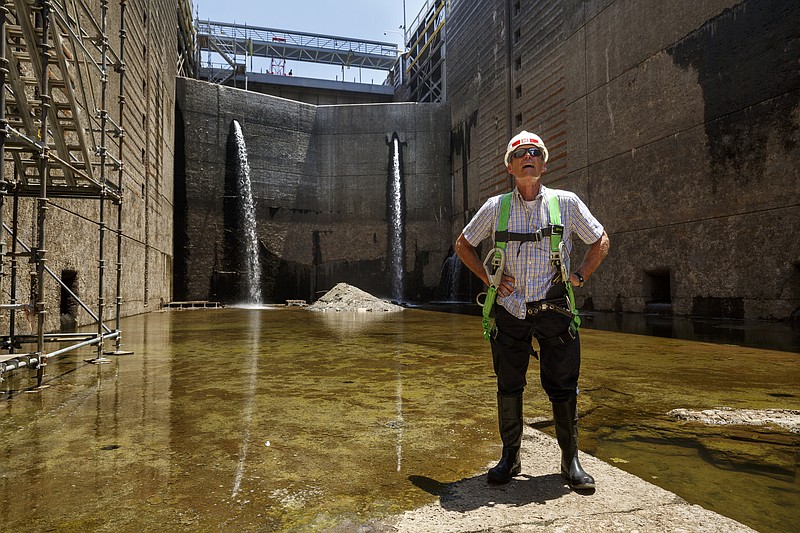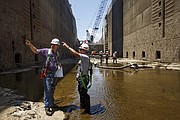Chattanooga's river artery for commerce is shut down this month as crews work to prevent a more permanent bottleneck in the upper third of the Tennessee River.
The Army Corps of Engineers drained the Chickamauga lock last week to allow work crews to inspect and replace valves, bushings and other equipment in the aging and crumbling lock at the Chickamauga Dam. The work began July 11 and will leave the lock between the Nickajack and Chickamauga Reservoirs shut down until Aug. 11.
The dewatering of the lock, which removed more than 10 million gallons of water from the 60-foot- by-360-foot lock chamber, is part of the Corps' maintenance schedule to maintain and protect the locks that allow river barges to move up and down the 652-mile Tennessee River system. The Corps had a similar month-long maintenance outage at the Chickamauga lock four years ago, and has had to briefly suspend operations several times since due to severe weather or equipment problems.
A crew of 45 engineers from across the Nashville District of the Army Corps of Engineers are working two 10-hour shifts every day to conduct tests and repairs to limit the length of the lock outage.
"This is the hottest time of the year, but it's the best time to avoid weather problems (from flooding or freezing)," said Greg Cox, the engineer in charge of the $1.3 million lock maintenance project.
With the lock temporarily out of service, barges are cut off from moving from Chattanooga to the upper 318 miles of navigable river above Chattanooga. The Corps gave several months notice for the planned maintenance dewatering this summer to allow businesses that rely upon river shipments to stock up and prepare for the temporary shutdown of the river.
"It's a good time for us to do maintenance and repairs," said Peter Serodino, who operates a barge hauling business in Chattanooga. "Barges usually back up above and below the lock (during such outages)."
The Chickamauga Lock is one of the most vulnerable inland locks operated by the Corps of Engineers. The lock was started in 1936 and finished in 1940 and used rock from a nearby quarry that contains aggregate that has caused "concrete growth" in the lock chamber and walls over the past 66 years of its operation.
"The lock is basically pushing itself apart," Cox said. "We have to go in periodically and inspect and adjust and valves, bushings and other gate parts to keep the lock in operation."
The Corps has spent more than $22 million since 1999 to install tension anchor rods, sandblast equipment, replace valves and bushings and make other improvements to protect the 76-year-old lock. Since its opening in 1940, engineers estimate the concrete growth has lengthened the lock chamber by more than a foot and added several inches to the height of the lock.
The goal is to keep the old, aging lock in operation until a new and bigger lock the new lock can be funded and finished.
The Corps has already spent $185 million over the past decade on road work, coffer dams and wall anchors for the new lock. But the Corps estimates it will cost another $570 millon to finish the new lock.
The new lock will be 110 feet wide and 600 feet long to accommodate multiple barges locking through at one time. It could be finished by 2022, if adequate funding is provided over the next six years.
Tommy Long, the Corps' resident engineer for the project, said bids will be let in September for excavation work for the new lock, using the nearly $30 million allocated to the project in the current fiscal year. The winning contractor will remove 100,000 cubic yards of rock from the riverbed to anchor the new lock, which will be built below the existing Chickamauga Dam.
Another $37 million will be needed to continue to new lock project on schedule in fiscal 2017, but a final budget has not yet been set by Congress for next year.
Contact Dave Flessner at dflessner@timesfreepress.com or at 423-757-6340.

